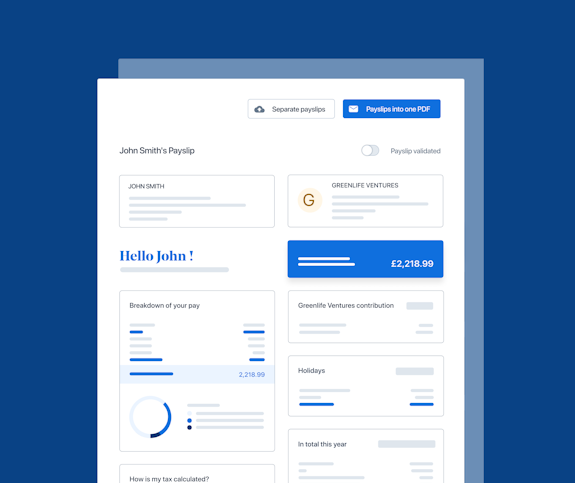- Blog
- |Managing Payroll
- >Payroll
- >spooky payroll stories
Four Spooky Payroll Scenarios and What to Do About Them


Spooky season is upon us!
The weather’s getting chillier, and the leaves a little crunchier - it must mean that autumn and Halloween are upon us.
As the days grow darker, we often get a munch on for scary stories that can chill us to the bones. And here at PayFit, we love a good (payroll-related) horror story!
So, we thought it would be fun to talk about some of the spookiest payroll scenarios you can encounter when running company payroll. We’re talking ghost employees, being audited by the wizards of HMRC and all things dark and mysterious that can disturb the peace of an otherwise standard payroll process.
On a lighter note, there are many things you can do to mitigate these risks - in other words, we’ll be sharing some handy tips you can apply in each of these scenarios to scare any ghouls away.
So grab a cuppa, settle down with your favourite blanket, and let’s hear all about these spooky payroll scenarios…
Four spooky payroll scenarios to look out for and how to handle them
Being haunted by a former employee
That’s right - turns out you can be haunted through your payroll (boo!).
In some cases, these are former employees who have left your company but who weren't removed from payroll. The same can happen when employees have passed away, and no one has informed you and your team of their death.
All too common, however, is that your company has fallen prey to a fraudulent scheme, such as where non-employees are purposely added to payroll. Now that’s pretty scary.
All these examples fall under the umbrella term ‘ghost’ employees that, quite literally, haunt your payroll (see, we weren’t joking). If not dealt with, you’ll continue sending money to these ‘other-worldly’ entities from your company’s bank account to theirs, causing your company to lose significant sums in the process.
So, who you gonna call? Well, in order to become a true ghost employee buster (see what we did there?), you’ll have to roll up your sleeves and dig into some details. If you suspect ghost employees are lurking in your payroll, you'll first want to run a self-audit. That will help you identify and terminate inactive employees still on your payroll system.
But detection is only part of the solution - you’ll also want to ensure this doesn’t keep happening in future. In other words, you’ll want to review and improve your existing payroll process regularly. Do you have the proper onboarding and offboarding checklists in place? Are your background checks thorough enough? Do you have a watertight way of collecting and verifying employee information before they start their first day?
All of these steps will help you better identify ghost employees and wash them out of your system while stopping any funds being funnelled to fraudulent accounts. No proton packs or ghost traps needed.

The Ministry of Revenue and Customs wants to audit your books
It’s easy to think of His Majesty’s Revenue and Customs Agency (HMRC) as that magical place, full of tax wizards and magicians, where we send all our FPSs and EPSs. Information goes in, and your NIC contributions and tax bill come out. Just like magic!
Stay in HMRC’s good books and you’ll, hopefully, never have to deal too closely with this mystical institution. Get a little lax, however, with payroll compliance, and you may become the subject of an unexpected PAYE audit. That’s when the taxman or woman pops over for a visit to inspect your payroll records. And, no, they’re not so easily won over by a warm cuppa and some lovely biscuits (...though they might appreciate the gesture!).
First things first, try to keep calm. While a payroll audit might sound scary, especially for small businesses with a finance department of one (or two), it’s not worth losing sleep over. A PAYE audit will simply gauge your level of payroll compliance and help uncover any inconsistencies, all too often down to harmless accounting mistakes. As long as you are cooperative and pleasant to deal with, it should all go by smoothly.
One thing you can do before the auditor arrives is to conduct your own internal audit (here’s a handy checklist you can run through to do this), something you should be doing anyway at least once a year to review employee wage and salary data. That way, you can identify any potential discrepancies beforehand and disclose these proactively.
And while it might feel like you’ve done something ‘wrong’, remember that operating payroll comes with a lot of complexities - especially with the introduction of things like RTI reporting and pension auto-enrolment. Unless you know exactly what you’re doing, it can be difficult to stay on top of compliance. Thankfully, that’s where payroll software comes in (of the HMRC-recognised kind).
You’ve got ‘creepy twins’ under the same NI number
Things are always a little more frightening when they come in pairs. Indeed, the horror movie genre understands all too well the trope of the creepy twins. But these can also crop up during your pay run in the form of two employees registered under the same NI number (yikes!). Or, in another mutation, as your payroll team mixing up two people’s NI numbers.
Now, on the surface, this might seem like a harmless clerical error. But the HMRC guidance for dealing with these kinds of mistakes isn’t overly clear. Worse, fail to correct this mistake, and you risk letting the rot set in - in other words, we’ve seen payroll bureaus, in particular, take years to rectify this kind of mistake, impacting client HMRC liabilities in the process (e.g. showing an under or overpayment that can accrue interest). Not to mention, HMRC might also issue an unnecessary tax code change if they believe an employee is receiving two salaries with the same employer.
So, how can you banish those creepy NI twins? Well, HMRC simply says to update your payroll records, so this is taken care of the following month. But we’d recommend correcting this anomaly straight away during the month it’s happened, even if that means submitting an FPS adjustment.
You should also follow up with HMRC to ensure the updated FPS has had the desired effect. And most importantly, don’t report updates to more than one of your employee’s personal details (for example, their name, DOB or gender) using the same FPS. Your payroll records might be duplicated if you do, leading to your PAYE bill being inaccurate.

Your payroll team is struck down by a mysterious illness
We’ve covered this before in our payroll disaster recovery guide - the possibility that your entire payroll team might suddenly vanish…or simply all come down with COVID.
Whether they’ve become trapped in the Upside Down or are simply under the covers with a hot water bottle, losing key members of your payroll team, even for just a few days, can be stressful, especially during prime payroll time at the end of the month.
So what should you do? If you’re in the midst of this kind of situation, all you can do really is to mobilise present staff as quickly as possible to make up for the shortfall. After all, your priority during these kinds of events is to always make sure your employees are still paid on time.
But in future, there’s a lot you can do to mitigate this kind of disaster. For one, you’ll want to ensure you’ve got more than one person in your company who’s trained to run payroll; that way, you avoid a single point of failure (SPOF). You’ll also want to have a clearly documented payroll process that anyone can pick up and follow. Of course, having user-friendly payroll software as part of your HR-Finance technology stack can make all of this much easier.
Don’t get too freaked out by these payroll scenarios!
Because with PayFit, it’s easy to avoid them.
Our platform can save up to 80% of time spent running payroll each month while eliminating silly mistakes caused by manual calculations and clunky spreadsheets.
With CIPP-level compliance baked into every aspect of our product, we take care of rule-following so you can refocus your energy on growing your business.
We’ve designed our software to keep up with legislation changes, so you never have to enter a rate or threshold change ever again. And with CIPP-trained payroll experts ready to help behind the scenes, you can get all your burning payroll questions answered.
Find out why over 10,000 businesses trust us with their payroll. Book your demo today.


A UK 4-Day Working Week - Thoughts On Labour’s Plan

Running payroll - A Guide For New Businesses

The Alabaster Ruling & Maternity Pay - A Guide For Employers

The End Of Zero Hours Contracts? Implications For Businesses

What is the HM Revenue and Customs Starter Checklist

